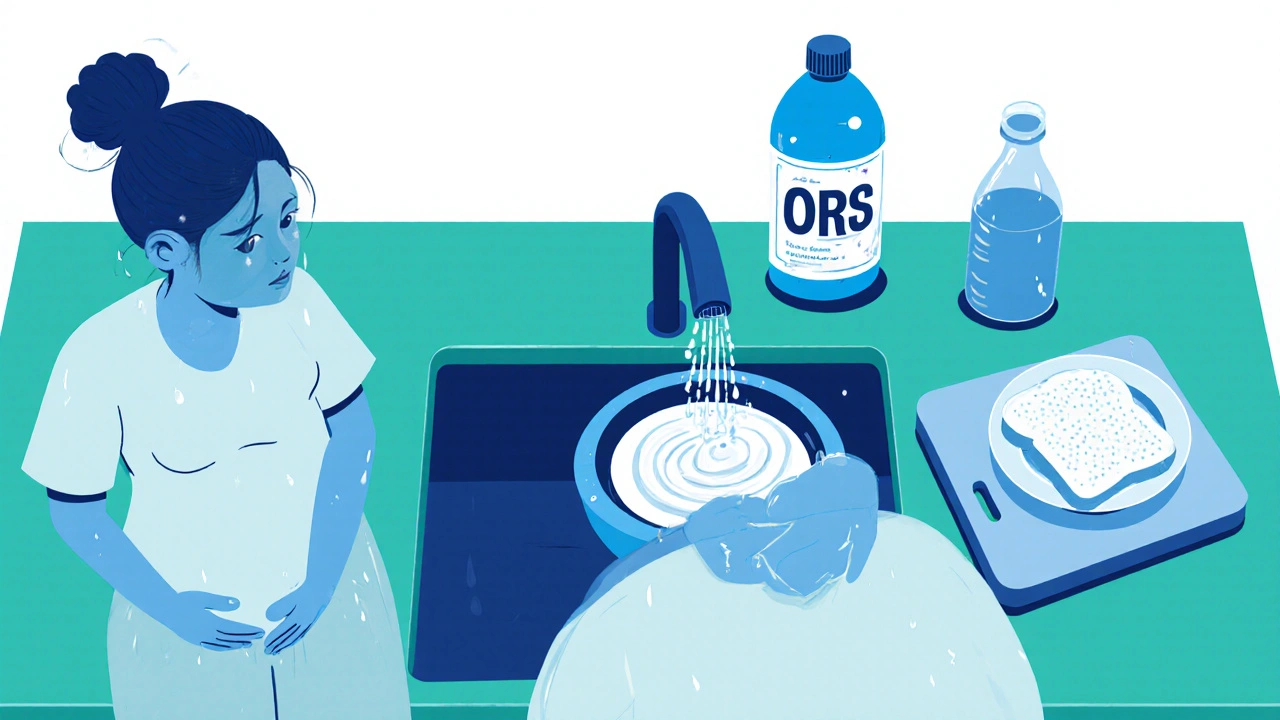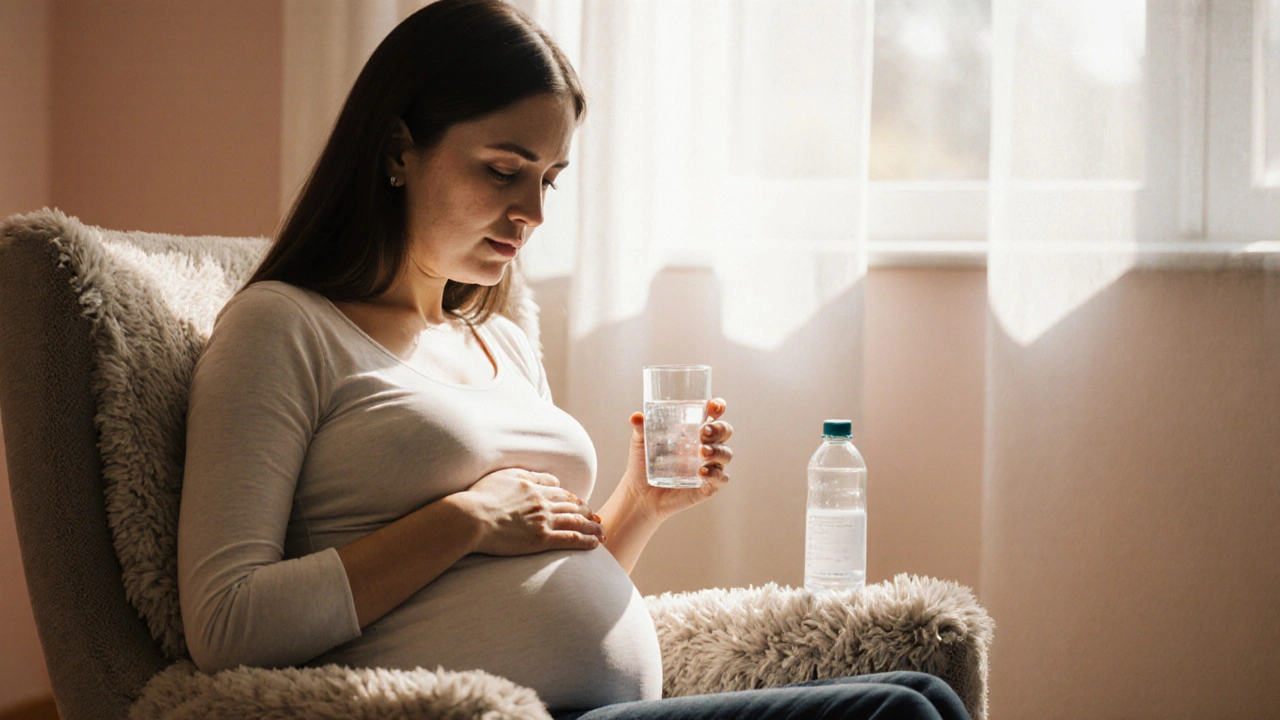Dehydration Risk Calculator for Pregnancy
Hydration Risk Assessment
This tool helps you assess your dehydration risk during gastroenteritis and provides personalized recommendations based on pregnancy-specific guidelines.
Your Risk Assessment
Recommended Actions
Quick Summary
- Gastroenteritis can cause dehydration, which is riskier in pregnancy.
- Common symptoms include watery diarrhea, vomiting, abdominal cramps, and fever.
- Most cases are viral and resolve with home care; antibiotics are only for bacterial causes.
- Oral rehydration solutions, certain probiotics, and pregnancy‑safe anti‑nausea meds help you stay hydrated.
- Seek medical attention if you have high fever, blood in stool, severe dehydration, or if you’re less than 24weeks gestation and symptoms persist.
What Is Gastroenteritis?
Gastroenteritis is an inflammation of the stomach and intestines, usually caused by viruses, bacteria, or parasites. The condition leads to watery diarrhea, vomiting, abdominal pain, and sometimes fever. In most healthy adults the illness runs its course in a few days, but in pregnancy the stakes are higher because the body is already working harder to support a growing baby.
How Pregnancy Affects the Illness
Pregnancy is a physiological state that changes fluid balance, immune response, and gastrointestinal motility. Increased progesterone relaxes the gut, which can slow down digestion and make nausea worse. At the same time, the plasma volume expands by about 40‑50%, so losing fluids quickly can lead to dehydration more easily than in non‑pregnant people.

Spotting the Symptoms
Typical signs to watch for include:
- Frequent loose or watery stools (more than three times a day)
- Vomiting that interferes with eating or drinking
- Stomach cramps or a feeling of “tummy pressure”
- Low‑grade fever (usually under 38.5°C/101.3°F)
- Signs of dehydration: dark urine, dry mouth, dizziness, or reduced fetal movement
If any of these symptoms appear alongside blood in stool, a fever above 38.5°C, or you can’t keep fluids down for more than 24hours, call your healthcare provider right away.
When to Call a Healthcare Provider
Pregnant people should err on the side of caution. Seek professional help if you experience:
- Persistent vomiting that prevents oral intake for over 12hours.
- Signs of severe dehydration (e.g., urine output less than 500ml per day, rapid heartbeat, faintness).
- High fever lasting more than 24hours.
- Blood, mucus, or a markedly foul odor in the stool.
- Sudden decrease in fetal movements after the first trimester.
Early medical intervention can prevent complications such as preterm labor or low amniotic fluid.
Safe Treatment Options
Most viral gastroenteritis cases improve with supportive care. The following approaches are considered safe for most stages of pregnancy.
1. Rehydration with Oral Rehydration Solutions (ORS)
Oral Rehydration Solution (ORS) is a balanced mixture of water, salts, and glucose. It restores electrolytes faster than plain water or sports drinks. Mix one liter of clean water with 6g of salt and 20g of sugar, or use pre‑packaged ORS sachets available at pharmacies. Sip small amounts every 5‑10minutes rather than drinking a large glass at once.
2. Probiotics
Specific strains such as Lactobacillus rhamnosus GG and Bifidobacterium lactis have shown modest benefits in shortening the duration of viral diarrhea. Look for prenatal‑safe probiotic supplements that list the exact CFU count and avoid products with added herbs.
3. Pregnancy‑Safe Antiemetics
If vomiting is frequent, doctors often prescribe doxylamine‑pyridoxine (Diclegis) or ondansetron after the first trimester when needed. Both have extensive safety data and can be taken short‑term under medical supervision.
4. Antidiarrheal Medications
Most over‑the‑counter antidiarrheals (e.g., loperamide) are not recommended during pregnancy because they may slow gut motility and affect nutrient absorption. Only a physician‑prescribed dose, if absolutely necessary, should be used.
5. Antibiotics
Antibiotics are reserved for bacterial gastroenteritis (e.g., Salmonella, Campylobacter). Safe options include amoxicillin or azithromycin, but the exact choice depends on the pathogen and gestational age.
Medication Safety Chart
| Medication | Category | Pregnancy Safety | Typical Use |
|---|---|---|---|
| ORS (e.g., Pedialyte) | Rehydration | Safe | Replace fluids & electrolytes |
| Doxylamine‑pyridoxine | Antiemetic | Safe (all trimesters) | Control nausea/vomiting |
| Lactobacillus rhamnosus GG | Probiotic | Safe | Shorten diarrhea duration |
| Loperamide | Antidiarrheal | Not recommended | Only under physician direction |
| Azithromycin | Antibiotic | Safe (2nd/3rd trimester) | Treat bacterial infection |
| Metronidazole | Antibiotic | Avoid in 1st trimester | Treat anaerobic bacteria |

Preventive Measures
Prevention reduces the odds of catching gastroenteritis during pregnancy. Simple habits go a long way:
- Wash hands with soap for at least 20seconds after using the bathroom, changing diapers, or handling raw meat.
- Avoid unpasteurized dairy products, raw eggs, and undercooked seafood.
- Steer clear of food prepared by someone who is ill with a stomach bug.
- Disinfect kitchen surfaces frequently with a bleach‑based cleaner.
- When traveling, drink bottled or boiled water and peel fruits yourself.
Potential Impact on the Baby
Maternal dehydration can lower amniotic fluid volume, which may affect fetal movement and growth. Fever above 39°C (102.2°F) in the first trimester has been linked to a slightly higher risk of neural‑tube defects, though the association is modest. Prompt rehydration and fever control keep both mom and baby safe.
Key Takeaways for Expecting Moms
- Stay hydrated with ORS; plain water isn’t enough when you’re losing electrolytes.
- Most cases are viral and resolve without antibiotics.
- Safe anti‑nausea meds like doxylamine‑pyridoxine are your friend.
- Know the red‑flag symptoms that require immediate medical attention.
- Practice rigorous hand‑washing and food safety to lower your risk.
Frequently Asked Questions
Can I take over‑the‑counter antacids for stomach upset?
Yes, antacids that contain calcium carbonate are generally safe in pregnancy. Avoid those with high sodium or magnesium if you have kidney issues. Always check the label for any added herbal ingredients.
Is it okay to use a probiotic yogurt while dealing with diarrhea?
Plain, pasteurized yogurt that lists live cultures is fine and can offer modest benefits. Choose low‑fat options if you’re watching calories, but the probiotic content is the main advantage.
How much fluid should I aim for each day during an episode?
Aim for at least 2.5liters (about 10 cups) of fluid, including ORS, clear soups, and water. If you’re still vomiting, sip a teaspoon every few minutes and gradually increase the amount.
When is it safe to resume normal diet after diarrhea?
Start with bland foods like toast, rice, bananas, and applesauce once stools are less watery (usually after 24‑48hours). Re‑introduce fiber gradually and avoid spicy or fatty foods for a few days.
Should I get a COVID‑19 test if I have gastrointestinal symptoms?
Yes, especially if you’ve been exposed or have other COVID‑related signs. Some variants present with diarrhea as a primary symptom, so a test helps rule out co‑infection.


Comments (8)
Jenn Zee
It is incomprehensible how many expecting mothers still cling to antiquated notions that “a little dehydration won’t hurt the baby,” when the literature unequivocally demonstrates the perilous cascade that follows. The physiological adaptations of pregnancy demand a rigorously calibrated fluid balance, yet the casual “just drink water” advice proliferates like a mantra of ignorance. One must appreciate that plasma volume expands by up to fifty percent, rendering any deviation from optimal hydration a potential threat to both uteroplacental perfusion and fetal well‑being. Moreover, the reduction in gastrointestinal motility caused by progesterone is not a benign inconvenience; it amplifies the vulnerability to persistent vomiting and subsequent electrolyte depletion. The author’s emphasis on oral rehydration solutions (ORS) is commendable, but it fails to stress that commercial sports drinks lack the precise sodium‑glucose ratio necessary for maximal absorption. The subtle nuance of using a 1:1:3 (sodium:glucose:water) mixture is a detail that should not be glossed over in any serious discourse. Additionally, the recommendation to avoid antidiarrheals like loperamide is not merely a precaution but an imperative, as slowed gut transit can exacerbate toxin retention and nutrient malabsorption. Pregnant individuals must also be vigilant for insidious signs such as diminished fetal movement, which may herald early hypovolemia. The relationship between maternal dehydration and reduced amniotic fluid volume, though occasionally understated, is a critical parameter that obstetricians monitor rigorously. It is equally vital to recognize that fever exceeding thirty‑nine degrees Celsius in the first trimester carries a documented, albeit modest, association with neural‑tube defects, thus underscoring the urgency of antipyretic therapy. While the article lists doxylamine‑pyridoxine as a safe antiemetic, it neglects to mention the growing body of evidence supporting the judicious use of ondansetron under specialist supervision, especially after the first trimester. Finally, the advice to resume bland foods should be accompanied by a timeline: typically 24‑48 hours after the cessation of watery stools, gradually re‑introducing fiber over the subsequent three to five days. In sum, the discourse demands a higher standard of precision, lest we perpetuate a hazardous complacency among those most in need of vigilant care.
Steph Hooton
Thank you for the comprehensive guide; it provides clear steps that can help keep both mother and baby safe during a difficult time. I appreciate the emphasis on ORS and the detailed fluid goals, as staying hydrated is truly essential. The advice to monitor fetal movement and seek help promptly is particularly reassuring. Your structured approach makes it easier for someone who may feel overwhelmed to follow a plan.
Judson Voss
Honestly, if you’re not already on a strict monitoring schedule, you’re gambling with your pregnancy. The article skims over the seriousness of prolonged vomiting and pretends it’s a minor inconvenience. The reality is that many women downplay symptoms until it’s too late, and that’s unacceptable.
Jessica Di Giannantonio
It’s so comforting to know that there are practical steps we can take even when we feel completely drained. The way you’ve broken down the fluid recommendations feels like a lifeline. I’m especially grateful for the gentle reminder to listen to our bodies and not ignore subtle cues.
RUCHIKA SHAH
Staying hydrated is key and simple actions like washing hands can prevent many cases. Keep it simple and stay safe.
Justin Channell
👍 stay strong keep sipping tiny amounts 💧 you got this
Basu Dev
From a clinical perspective, the pathophysiology of dehydration in pregnancy can be delineated into three interrelated mechanisms: firstly, the increased plasma volume that characterizes gestation renders the maternal organism more susceptible to even modest fluid losses; secondly, progesterone‑induced hypomotility of the gastrointestinal tract prolongs the duration of vomiting and diarrhea; and thirdly, the altered renal handling of electrolytes during pregnancy can exacerbate the sequelae of fluid depletion. Consequently, the therapeutic regimen must address each of these components in a coordinated fashion. Oral rehydration solutions, when formulated with the appropriate osmolarity-approximately 245 mOsm/kg-optimally facilitate sodium and glucose co‑transport, thereby maximizing intestinal fluid uptake. In addition, the judicious use of antiemetics such as doxylamine‑pyridoxine, which have an established safety profile across all trimesters, can truncate the vomiting cycle and allow for adequate oral intake. Probiotic supplementation, particularly strains like Lactobacillus rhamnosus GG, has modest evidence supporting a reduction in the duration of viral diarrheal episodes, and may be considered adjunctive therapy. It is imperative, however, to avoid over‑reliance on antidiarrheal agents like loperamide, as they may interfere with the necessary clearance of pathogens and toxins. Finally, vigilance for red‑flag symptoms-persistent high‑grade fever, hematochezia, oliguria, or a sudden decline in fetal movements-should trigger immediate medical evaluation, as these may herald complications such as preterm labor or fetal compromise. By integrating these evidence‑based interventions, clinicians can mitigate the risks associated with gastroenteritis in pregnant patients.
Krysta Howard
While the article is generally solid, it totally omits the role of zinc supplementation, which has been shown to reduce the duration of diarrhea. Also, the recommendation to avoid loperamide isn’t absolute; in severe cases under specialist supervision, it can be justified. Providing a nuanced view would make the guide more trustworthy.